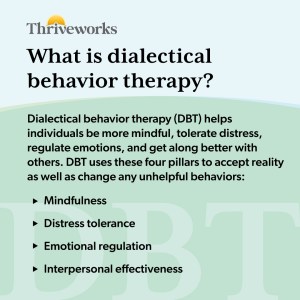Dialectical behavior therapy (DBT) is a staple in modern therapeutic treatment, being one of the more common therapy approaches used today. It even shares many similarities with cognitive behavioral therapy, another of the most common therapeutic approaches.
DBT can be very effective in treating borderline personality disorder (BPD), as well as substance abuse issues and eating disorders. Though it can theoretically be used to treat a variety of conditions, DBT is grounded in treating a specific set of symptoms, and it is up to mental health professionals to decide when and where it will be most effective.
What Is Dialectical Behavior Therapy (DBT)?
Dialectical behavior therapy, commonly known as DBT, is an evidence-based form of therapy that combines behavior therapy, cognitive behavioral therapy, and mindfulness principles. “Dialectic” refers to holding two contrary perspectives as true.
Developed by clinical psychologist Marsha Linehan, DBT uses a flexible set of stages that helps people accept the reality of their life and behaviors as well as change any unhelpful behaviors that are affecting their lives. DBT focuses on managing your emotions and connecting them with your thoughts and behaviors in order to help you learn to self-regulate.
Traditionally, DBT has been helpful in treating symptoms associated with borderline personality disorder, though it’s commonly used to treat other conditions as well.
What Does Dialectical Behavior Therapy Do? How Dialectical Behavior Therapy Works
Dialectical behavior therapy is intended to help individuals be more mindful, tolerate distress, regulate emotions, and get along better with others. DBT relies on skill acquisition achieved within its four components: mindfulness, distress tolerance, emotional regulation, and interpersonal effectiveness.
DBT is similar to traditional therapy in which the client meets with the therapist in a one on one setting, though it can also be practiced in a group setting or through over-the-phone coaching. DBT operates in four stages:
- Stabilization. The purpose of this stage is to immediately address the most extreme and destructive behaviors that are present—the ones causing you the most emotional distress. Addressing and stabilizing these behaviors gives you a stable base for deeper emotional work to start from.
- Exploring feelings. This stage focuses on your emotional experience and how it’s affecting your quality of life. You’ll begin to work through your intense emotions, often tied to traumatic or distressing experiences, and identify why they’re occurring. From there, you focus on treating these areas and helping them heal.
- Quality of life. In this stage, you will apply techniques or skills to improve the quality of your life. Now, you’ll work to improve self-esteem, create goals for yourself, manage your emotions on your own (self-regulate), and overall learn to live in a healthy way on your own.
- Deeper meaning. This stage focuses on helping you find a spiritual connection with the world, increasing your capacity for positivity. During this time, you’ll address techniques that will help you make the most out of life.
As stated above, these stages are flexible, meaning that not every patient will go through them in the same order, or even go through each of them. Therapists often skip around or move past certain stages depending on the emotional needs of the client—though stage four is necessary for everyone doing DBT. However, some people experience discomfort with matters of spirituality or religion. If this is the case, the clinician may modify their interventions so as to not offend their client’s belief system.
What Are the 4 Pillars of Dialectical Behavior Therapy?
The four components of dialectical behavior therapy include:
- Mindfulness involves being aware of one’s internal state. This can include observation, describing one’s emotional state, and participating with one’s current situation.
- Distress tolerance involves coping with uncomfortable feelings. This can include distraction, self-soothing activities, and focusing on the pros and cons and ways to improve the moment.
- Emotional regulation helps with managing intense uncomfortable feelings. This can include naming and understanding feelings, limiting one’s vulnerability to certain feelings, and decreasing emotional suffering.
- Interpersonal effectiveness skills involve the usefulness of our relationship with others. This can include communicating with others, improving the efficacy of the relationship, increasing self respect, and balancing “wants” and “shoulds.”
Skills Taught in Dialectical Behavior Therapy
DBT teaches people many useful and helpful skills for managing emotions and behaviors. Examples of these skills include:
- Mindfulness skills: Observing, describing and participating mindfully, focusing on only the present in a non-judgmental way.
- Relationship/interpersonal effectiveness skills: Working to maintain balanced, healthy, and safe relationships
- Distress tolerance skills: Learning to tolerate and work through unavoidable pain without letting old patterns make it worse.
- Emotional regulation: Observing, understanding, and dealing with your emotions in a healthy way.
Each of these skills can help break harmful old patterns and allow you to live a healthier, happier life.

Who Can Benefit from DBT?
DBT can be especially beneficial for those with:
- Dysregulated moods
- Self-destructive tendencies
- Suicidal behaviors
- Disordered eating
- Trauma
- Substance abuse/misuse
- Mood disorders
DBT is also beneficial for children, adolescents, and adults. Components of DBT have been used in conjunction with other forms of therapy such as person-centered therapy or cognitive behavioral therapy to help individuals’ manage anything from everyday concerns to longstanding marital issues.
Hello, we're here to help you
We provide award-winning mental health services nationwide, with flexible scheduling & insurance coverage. Start your journey this week.
DBT Techniques for Emotional Regulation
Emotional regulation refers to your ability to manage your emotional reaction. Emotional dysregulation, or an inability to effectively manage emotions, is often associated with mood disorders, borderline personality disorder, autism spectrum disorder, trauma response, and the effects of a brain injury.
The acronym “PLEASE” can help people regulate their emotions by decreasing emotional vulnerability.
- P(L) – Physical illness treatment. When you’re not feeling your best, it’s hard to provide balanced responses. When you’re feeling emotionally dysregulated, make sure to check in with your body—is there any pain or discomfort happening that you can treat?
- E – Eat a balanced diet. Try to give your body the sustenance and nourishment it needs by decreasing consumption of foods high in fat, caffeine, and sugar.
- A – Avoid mood-altering drugs. This refers to unregulated substances that artificially stimulate or depress mood, consequently affecting your behavior.
- S- Sleep. Get sufficient sleep each night—aim for eight uninterrupted hours.
- E- Exercise daily. Try to incorporate physical activity into your daily routine, such as walks or even a dance break.
Learning emotional regulation skills with DBT encourages individuals to understand their emotions and name them. This can include distinguishing a primary emotion (the first/immediate response to a trigger) from a secondary emotion (response to a primary emotion or thought).
How Does Addressing Borderline Personality Disorder With DBT Work?
Dialectical behavior therapy was developed by clinical psychologist Marsha Linehan, Ph.D., who essentially created a form of treatment to address her own symptoms, a set of symptoms that would be later diagnosed as borderline personality disorder. She describes DBT as “a synthesis or integration of opposites.”
Borderline personality disorder is a mental health diagnosis characterized by unstable relationships with others, an unstable view of themselves, shifts in how feelings are experienced, and noticeable impulsivity.
In turn, DBT targets awareness, interpersonal relationship skills, regulation of one’s feelings, and an ability to tolerate distress. DBT also works at reducing self-harming behaviors generally associated with borderline personality disorder. Some of the self-harming behaviors that decreased included binging and purging and substance use, which strongly suggests DBT can be very effective at treating eating disorders and substance abuse as well.
Effectiveness of Dialectical Behavior Therapy
Through several randomized controlled trials, DBT has been found to be an effective form of therapy. One study found that after one year of treatment, over 75% of the clients with borderline personality disorder no longer met criteria for BPD.
What Is Better for ADHD: CBT or DBT?
The debate of CBT vs. DBT is one that is discussed often for a variety of conditions, such as attention-deficit/hyperactivity disorder (ADHD). Cognitive behavioral therapy may be a bit more appropriate for ADHD than DBT, but only by a small margin. The effectiveness of each is also contingent on approach preferences for the client and therapist as well any comorbidities the client might have.
ADHD is a neurodevelopmental disorder that affects attention, organization, activity level and impulse control.
CBT is a type of therapy that combines cognitive therapy and behavior therapy. It functions from the assumption that all thoughts, feelings, and behaviors are connected. The target of CBT is to change unhelpful thoughts and behaviors, which can be very helpful for those with ADHD that struggle with executive functioning.
Some common techniques used in CBT to help manage ADHD symptoms are:
- Cognitive restructuring: Helps identify negative thoughts, challenge them, and change them so that they become reasonable.
- Time management: Helps manage the organization of tasks and activities, helping to decrease procrastination.
- Problem-solving skills: Can help with finding misplaced items or other memory issues faced but those with ADHD.
- Social skills: Helps people refrain from intruding on others conversations or interjecting and instead wait for one’s turn
- Coping skills: Helps with managing criticism and negative evaluations, learning to handle the emotions that follow in a healthy way.
On the other hand, DBT can also provide helpful techniques for managing ADHD symptoms, such as:
- Mindfulness: Helps people slow down and focus on the present, quieting racing thoughts.
- Distress tolerance: Helpful for managing the frustration and overwhelm that often comes with decision-making.
- Emotional regulation: Allows individuals to manage uncomfortable emotions and impulses, something that people with ADHD regularly have to balance.
- Interpersonal effectiveness: Assists people with developing prosocial behaviors, such as effective ways to interact with others.
Though DBT was created to treat BPD, it is a flexible and versatile approach with many useful techniques that can be applied in many settings. In the end, though, it will be up to each mental health professional to decide what techniques will benefit their client more—oftentimes, the use of multiple (also known as an eclectic approach) is the right way to go.













